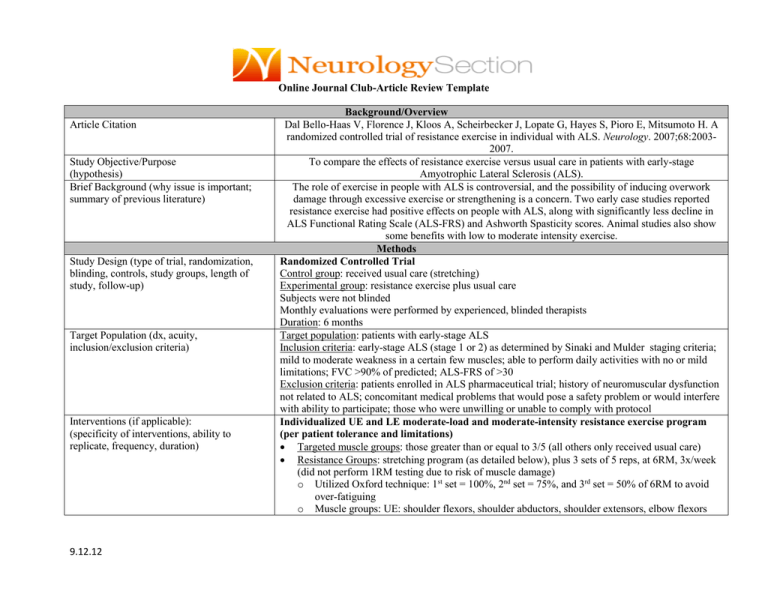Journal Club Summary
advertisement

Online Journal Club-Article Review Template Article Citation Study Objective/Purpose (hypothesis) Brief Background (why issue is important; summary of previous literature) Study Design (type of trial, randomization, blinding, controls, study groups, length of study, follow-up) Target Population (dx, acuity, inclusion/exclusion criteria) Interventions (if applicable): (specificity of interventions, ability to replicate, frequency, duration) 9.12.12 Background/Overview Dal Bello-Haas V, Florence J, Kloos A, Scheirbecker J, Lopate G, Hayes S, Pioro E, Mitsumoto H. A randomized controlled trial of resistance exercise in individual with ALS. Neurology. 2007;68:20032007. To compare the effects of resistance exercise versus usual care in patients with early-stage Amyotrophic Lateral Sclerosis (ALS). The role of exercise in people with ALS is controversial, and the possibility of inducing overwork damage through excessive exercise or strengthening is a concern. Two early case studies reported resistance exercise had positive effects on people with ALS, along with significantly less decline in ALS Functional Rating Scale (ALS-FRS) and Ashworth Spasticity scores. Animal studies also show some benefits with low to moderate intensity exercise. Methods Randomized Controlled Trial Control group: received usual care (stretching) Experimental group: resistance exercise plus usual care Subjects were not blinded Monthly evaluations were performed by experienced, blinded therapists Duration: 6 months Target population: patients with early-stage ALS Inclusion criteria: early-stage ALS (stage 1 or 2) as determined by Sinaki and Mulder staging criteria; mild to moderate weakness in a certain few muscles; able to perform daily activities with no or mild limitations; FVC >90% of predicted; ALS-FRS of >30 Exclusion criteria: patients enrolled in ALS pharmaceutical trial; history of neuromuscular dysfunction not related to ALS; concomitant medical problems that would pose a safety problem or would interfere with ability to participate; those who were unwilling or unable to comply with protocol Individualized UE and LE moderate-load and moderate-intensity resistance exercise program (per patient tolerance and limitations) Targeted muscle groups: those greater than or equal to 3/5 (all others only received usual care) Resistance Groups: stretching program (as detailed below), plus 3 sets of 5 reps, at 6RM, 3x/week (did not perform 1RM testing due to risk of muscle damage) o Utilized Oxford technique: 1st set = 100%, 2nd set = 75%, and 3rd set = 50% of 6RM to avoid over-fatiguing o Muscle groups: UE: shoulder flexors, shoulder abductors, shoulder extensors, elbow flexors Outcome Measures (relevant to purpose of the study; reliable, valid, clinical utility) Statistical Analysis (statistics used, appropriate application) Enrollment/Subject Characteristics (sample size, gender, age, functional level; were groups similar on important variables prior to application of the intervention) Summary of Primary and Secondary Outcomes (include aggregate and sub-group findings if reported); note results that were statistically significant; How many reached a level of clinical significance (exceed MCID if known); Was there retention of changes following intervention (if studied) Brief Summary of Authors’ Main Discussion Points; Authors’ Conclusion and extensors, LE: hip flexors, hip extensors, knee flexors, knee extensors, and ankle DFs Usual Care: stretching of bilateral quads, hamstrings, gastrocnemius, ankle DFs, and UE shoulder flexors, extensors, adductors and abductors; instructions/dosage: 5x30sec each, 1x/day Written instructions, diagrams, and tracking logs were provided for each group ALS-Functional Rating Scale, Fatigue Severity Scale (FSS), Short Form 36, MVIC, and FVC (latter two were utilized to monitor for signs of adverse effects of exercise) Kolmogorov-Smirnov test of normality was non-significant for all variables except for baseline SF36 Wilcoxon Rank Sum for the R-P subscales of the SF-36 t-test for outcome measures at 3 and 6 months t-test, X^2 or Fisher exact test for baseline characteristics p<0.05 was considered significant Intention to treat analysis did not show a difference between the groups Results 27 patients were randomly assigned: 13 to resistance exercise group, 14 to usual care group Resistance group: 11 participants were analyzed at 3 months, and 8 participants were analyzed at 6 months Usual care group: 14 participants were analyzed at 3 months, and 10 participants were analyzed at 6 months There were no differences in demographic and other variables between groups, although there was a trend toward a worse SF-36 physical functioning score in the usual care group At 3 months: the resistance exercise group had a significantly higher ALS-FRS score At 6 months: the resistance exercise group had significantly higher ALS-FRS scores and SF-36 physical function subscale scores Less decline in leg strength: measured by MVIC was found in the resistance exercise group No adverse events related to intervention occurred in either group, as indicated by MVIC and FVC No difference was found in FVC at 3 or 6 months Authors’ Discussion and Conclusions Per author: we have observed clinically that moderate resistance exercise programs implemented early can reduce the complications associated with disuse atrophy No adverse effects were found with resistance exercise, as previously thought Resistance exercise may be an essential component of the overall care of the patients with this disease, despite the poor prognosis Reviewer’s Discussion and Conclusion 2 Study Strengths Study Limitations and Potential for Bias RCT Six-month follow up (difficult to obtain given nature of disease progression in this population) Sample size and subsequent difficulty of recruiting and retaining subjects in this population given diagnosis and disease progression FSS may not be sensitive enough to detect change in our ALS population, however both groups had higher fatigue scores by 6 months Exercises were completed at home only Study didn’t report survival rate 5/13 of the resistance group and only 2/14 in the usual care group were taking Riluzole Patients in early stages of ALS Outpatient vs. Home therapy Guidance for exercise prescription for other neuromuscular disorders (NMDs) in regards to avoiding over-fatigue Applicability: Types of patients (dx) that results apply to Types of settings or patient acuity that the results apply to Can interventions be reproduced? Can results be applied to other pt populations? How will study results impact PT Patients with ALS who participate in an exercise program may have a greater sense of control over management of this patient population?; List what is happening to their bodies. This could increase their sense of autonomy in regards to their suggestions for how to implement changes in healthcare, especially given their limited lifespan. your clinic/department to integrate study In regards to Physical Therapy management and our evolving healthcare system, this study may findings into patient care support the trend towards visiting your Physical Therapist once a month, with utilization of online check-ins to monitor and adjust treatment as needed. 3





